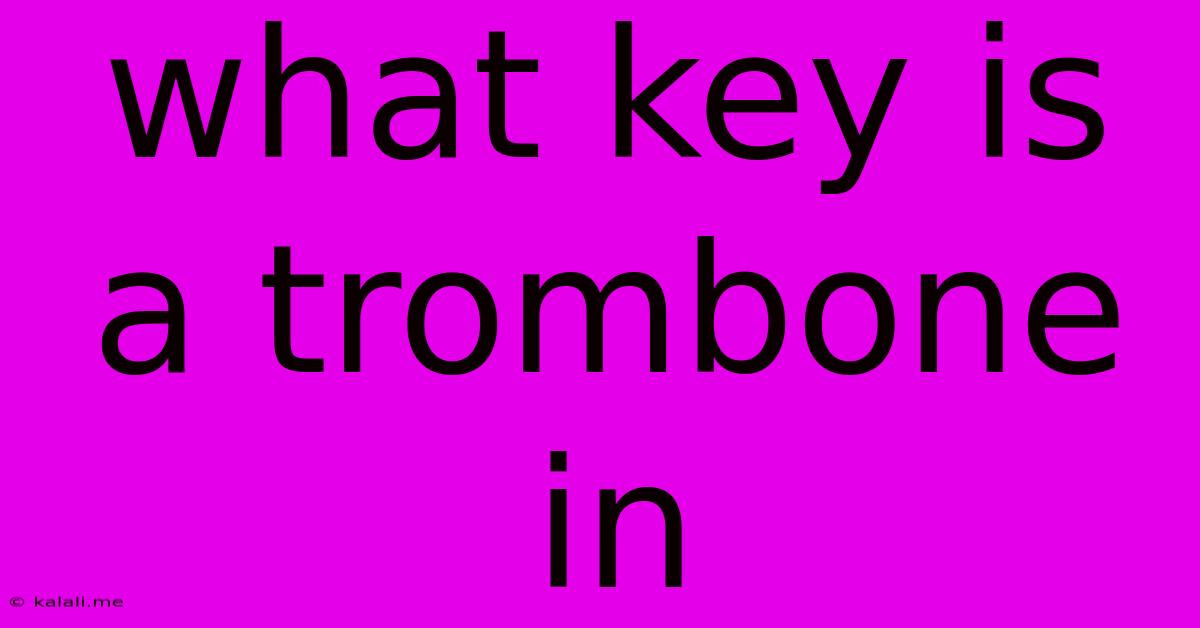What Key Is A Trombone In
Kalali
Jun 04, 2025 · 3 min read

Table of Contents
What Key is a Trombone In? Unlocking the Mystery of the Slide
The trombone, with its distinctive slide and rich, resonant tone, often sparks the question: what key is it in? The answer, unlike many other instruments, isn't straightforward. This article will delve into the unique nature of the trombone's key signature and explain why it's different from instruments with fixed pitches. This will cover the trombone's versatility, its relationship to other instruments, and practical implications for musicians.
The Trombone's Unique Nature: A Transposing Instrument
Unlike instruments like the clarinet or trumpet, which are typically considered to be in a specific key (like B♭ for clarinets or B♭ for trumpets), the trombone is a non-transposing instrument. This means it doesn't have a fixed key signature. It plays the written notes as they appear on the music. The pitch is determined entirely by the position of the slide.
This ability to freely change pitch without valves or keys is the trombone's defining characteristic. Its range spans a wide spectrum, encompassing multiple octaves. This means a trombonist can easily play in any key, making it incredibly versatile in orchestral and ensemble settings.
How the Slide Affects Pitch
The trombone's slide works by altering the length of the vibrating air column within the instrument. Moving the slide outwards lowers the pitch, while moving it inwards raises the pitch. This allows the player to precisely control the pitch, producing notes across a broad range.
The Concept of "Concert Pitch" vs. "Written Pitch"
It's crucial to differentiate between concert pitch (the actual sound produced) and written pitch (the note as it appears on the music). For a non-transposing instrument like the trombone, these two are identical. What you see on the page is what you hear. This contrasts with transposing instruments, where the written notes must be transposed to understand the actual pitch.
Playing in Different Keys: Ease and Effortlessness
The absence of a fixed key makes the trombone exceptionally adaptable. Moving from a piece in C major to one in F major simply involves adjusting slide positions accordingly. The written music remains consistent; only the slide positions change to produce the correct pitch. This adaptability contributes significantly to the trombone's wide-ranging musical capabilities and why its considered so versatile by composers.
The Trombone in Ensemble Settings
In orchestras and bands, the trombone's ability to play in any key is invaluable. It seamlessly integrates with other instruments, regardless of their key signature. This inherent flexibility makes it a crucial instrument across genres and musical styles.
Understanding the Trombone's Range
While the trombone doesn't have a key, it does have a range. Typically, a tenor trombone's range extends from around E2 to E6. The exact range can slightly vary depending on the player's skill and the specific instrument. However, within this considerable range, the player can produce notes across many keys and tonalities.
In conclusion, the question "What key is a trombone in?" has a unique answer. It's not limited to a particular key. The trombone's slide mechanism allows for its extensive versatility, enabling it to play in any key and make it an indispensable instrument in diverse musical contexts. Its adaptability and broad tonal range underscore its unique contribution to the musical landscape.
Latest Posts
Latest Posts
-
Mounting Tv To Metal Stud Wall
Jun 06, 2025
-
When Does An Infinite Geometric Series Not Have A Sum
Jun 06, 2025
-
Measure Length Of Curve The Would Be Flattened
Jun 06, 2025
-
Whats A Word To Describe Someone Who Doesnt Have Class
Jun 06, 2025
-
Vader In Bacta Tank Rogue One
Jun 06, 2025
Related Post
Thank you for visiting our website which covers about What Key Is A Trombone In . We hope the information provided has been useful to you. Feel free to contact us if you have any questions or need further assistance. See you next time and don't miss to bookmark.